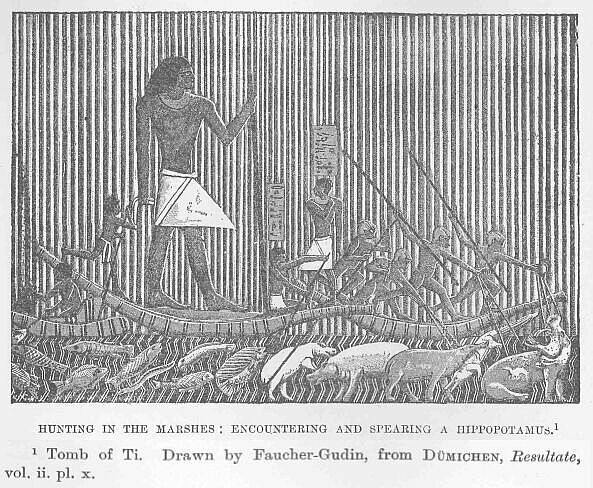Where does the whole idea that ancient Egyptians walked with one hand up in fron and the other down in back. I’m refering to the Walk Like an Egyptian walk of the Bangles and Steve Martin. I think it must have come from depictions in relief paintings or something, but I can’t find one.
I can’t remember seeing one IRL. I suppose it’s based on the stylized poses in ancient Egyptian art, but those were based on specific, actual activities and I cannot imagine how that would fit in.
I’m going out on a limb and blaming 20th century cartoons.
By gosh! I assumed it’d be easy to find at least one authentic picture in the pose, but I can’t.
Via Project Gutenberg:








Those links are referrer-protected, and I only count two of 'em that have the egyptian walk. The rest just seem like random paintings?
The Egyptians had an artistic convention that faces had to be shown in profile… but at the same time they preferred to show the body from the front. Meanwhile they would be shown walking the direction they were facing, which was sideways relative to the body. I suppose it came about that way because artists had not figured out how to show a three-dimensional scene on a flat surface. There is no depth to the paintings. The result being those unnaturally contorted poses that never occur in real life. Until the 1980s when life finally got around to imitating art.
As Johanna said, ancient Egyptians had a very stylized type of art. Each body part was show in it’s most “recognizable” position. Feet were always sideways, faces were always in profile.
This image is very similar to the “walk like an Egyptian” pose:
http://www.allposters.com/-sp/Egyptian-Bas-Relief-Posters_i876062_.htm
This is interesing, the feet face one direction, the face points the other direction, and the body faces forward.
http://www.molon.de/galleries/Egypt/Luxor/Karnak/img.php?pic=15
These kinds of distorted figures led to commedians joking about what Egyptians must have look like when they walked. I don’t know when the joke started - maybe during the King Tut craze in the 1920s, or maybe in early cartoons.
I blame Steve Martin.
I blame Wilson, Kepple and Betty
The first time I ever saw it “on screen” was in some cartoon, probably of late 1950s to mid 1960s vintage.
My bolding.
Not quite always. See the musicians in this wall paintingfrom the tomb of Nebamun, a temple accountant/tax-collector. (It’s the musicians’ faces you’re meant to be looking at - not the dancers ![]() Looks a fun party…)
Looks a fun party…)
It’s mentioned in “To Kill A Mockingbird.” Jem demonstrates it for Scout, who wonders how Egyptians got anywhere walking like that.
No way. I asked pretty much every single person who’s ever been to Egypt whether the people there actually walk ‘like that’, and they all told me yes. Was I lied to? Please tell me I wasn’t lied to!
I blame the Bangles.
I blame Aerosmith & Run-DMC
I actually had that painting in mind as a counterexample. I wondered why it would be an exception. The subject as a whole is a late (New Kingdom) departure from classical Egyptian artistic conventions. Old Kingdom art was limited to gods, royalty, and aristocracy, in highly formal scenes and those formalized poses. Naturalistic art like the Nebamun fresco didn’t develop until the New Kingdom, and was not the norm. Do look at the dancers too, their bodies are shown from the side or maybe a three-quarter aspect, which is another departure from convention. It would be kind of impossible to suggest any dance movement at all if limited to the classical conventions. That’s my guess anyway.
I saw these paintings in the new gallery in the British Museum recently. They are brilliantly presented and amazing representations of an idealised picture of the life of a wealthy Egyptian but, as you say, they are almost unique in their disregard of the normal conventions of Ancient Egyptian painting.
As far as I remember the museaun did not really present any strong argument for why they are different. Possibly just the painter was a genius and refused to be confined. Having just come from looking at Minoan and Myceanean material I did wonder if there was some cross-over but just speculation without knowledge on my part!
Not at all. And to answer your other question about if it’s true what they say about there being “a place in France where the naked ladies dance”… Yes, that is also true.
I have been to Egypt six times. I have seen hundreds and hundreds of depictions like the flat style linked here, but have never seen a single one with one arm up and forward and fingers pointed to the front, and the other arm down and back and the fingers pointed to the rear. And I’ve been looking for them.